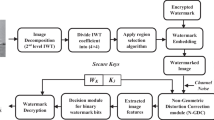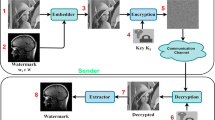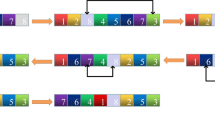Abstract
In the digital world, watermarking technology is a solution for data hiding and completely essential for management and secure communications of digital data propagated over the internet-based platforms. Reversible watermarking is a quality-aware type of watermarking which has been applied in managing digital contents such as digital images, texts, audios and videos. Reversible watermarking is also known as lossless watermarking due to its preservation of all details of host and hidden data. One of the important uses of this kind of watermarking is to manage medical data regarding DICOM images. In the recent years, a new type of reversible watermarking technology entitled interpolation-based reversible watermarking has been introduced, and we are going to enhance it for DICOM images by using a hybrid approach based on computing error histogram and by applying an image interpolation with greedy weights (adaptive weighting). In practice, simulation results clearly show better performance of the proposed scheme compared to the previous techniques using interpolation-based reversible watermarking on different DICOM images.










Similar content being viewed by others
References
Abd-Eldayem M (2013) A proposed security technique based on watermarking and encryption for Digital Imaging and Communications in Medicine. Egypt Inform J 14:1–13
Lin C-C, Tai W-L, Chang C-C (2008) Multilevel reversible data hiding based on histogram modification of difference images. Pattern Recogn 41:3582–3591
Luo L, Chen Z, Chen M, Zeng X, Xiong Z (2010) Reversible image watermarking using interpolation technique. IEEE Trans Inf Forensics Secur 5(1):187–193
Arabzadeh M, Helfroush MS, Danyali H, Rahimi MR (2011) DE-based reversible medical image authentication using hamming code. In: International e-conference on computer and knowledge engineering (ICCKE), pp 183–188
Arabzadeh M, Danyali H, Helfroush MS (2010) Reversible watermarking based on interpolation error histogram shifting. In: International symposium on telecommunications (IST’2010), pp 840–845
Dragoi I, Coltuc D (2014) Local-prediction-based difference expansion reversible watermarking. IEEE Trans Image Process 23(4):1779–1790
Wen J, Lei J, Wan Y (2012) Reversible data hiding through adaptive prediction and prediction error histogram modification. Int J Fuzzy Syst 14(2):244–256
Zhang S, Gao T, Yang L (2016) A reversible data hiding scheme based on histogram modification in integer DWT domain for BTC compressed images. Int J Netw Secur 18(4):718–727
Tian J (2003) Reversible data embedding using a difference expansion. IEEE Trans Circuits Syst Video Technol 13(8):890–896
Gonzalez RC, Woods RE (2008) Digital image processing, 3rd edn. Prentice Hall, NJ
Zhang L, Wu X (2005) Color demosaicking via directional linear minimum mean square-error estimation. IEEE Trans Image Process 14(12):2167–2178
Zhang L, Wu X (2006) An edge-guided image interpolation algorithm via directional filtering and data fusion. IEEE Trans Image Process 15(8):2226–2238
Zhang L, Wu X, Buades A, Li X (2011) Color demosaicking by local directional interpolation and nonlocal adaptive thresholding. J Electron Imaging 20(2):023016
Getreuer P (2011) Zhang-Wu directional LMMSE image demosaicking. Image Process Line (IPOL) 1:117–126
Lee S, Kang M, Uhm K, Ko S (2016) An edge-guided image interpolation method using taylor series approximation. IEEE Trans Consum Electron 62(2):159–165
Baghaie A, Yu Z (2015) Structure tensor based image interpolation method. Int J Electron Commun (AEÜ) 69:515–522
Khosravi MR, Rostami H (2016) A new statistical technique for interpolation of landsat images. In: ICAUCAE 2016, SID Conference Publications, Tehran, Iran
Colonnese S, Rinauro S, Scarano G (2013) Bayesian image interpolation using Markov random fields driven by visually relevant image features. Sig Process Image Commun 28:967–983
Malik A, Sikka G, Verma H (2016) An image interpolation based reversible data hiding scheme using pixel value adjusting feature. Multimedia Tools Appl 76:13025–13046
Chang Y-T, Huang C-T, Lee C-F, Wang S-J (2013) Image interpolating based data hiding in conjunction with pixel-shifting of histogram. J Supercomput 66:1093–1110
Lu T-C, Chang C-C, Huang Y-H (2014) High capacity reversible hiding scheme based on interpolation, difference expansion, and histogram shifting. Multimedia Tools Appl 72:417–435
Golpira H, Danyali H (2011) Reversible medical image watermarking based on wavelet histogram shifting. Imaging Sci J 59:49–59
Lei B, Tan E, Chen S, Ni D, Wang T, Lei H (2014) Reversible watermarking scheme for medical image based on differential evolution. Expert Syst Appl 41:3178–3188
Rocek A (2016) A new approach to fully-reversible watermarking in medical imaging with breakthrough visibility parameters. Biomed Signal Process Control 29:44–52
Ni Z, Shi Y, Ansari N, Su W (2006) Reversible data hiding. IEEE Trans Circuits Syst Video Technol 16(3):354–362
Hwang J, Kim JW, Choi JU (2006) A reversible watermarking based on histogram shifting. Lecture notes in computer science. Springer, Berlin
Hu Y, Lee H, Li J (2009) DE-based reversible data hiding with improved overflow location map. IEEE Trans Circuits Syst Video Technol 19(2):250–260
Arabzadeh M, Rahimi MR (2012) Reversible data hiding scheme based on maximum histogram gap of image blocks. KSII Trans Internet Inf Syst 6(8):1964–1981
Arabzadeh M, Helfroush MS, Danyali H, Kasiri K (2011) Reversible watermarking based on generalized histogram shifting. In: 18th IEEE international conference on image processing (ICIP), pp 2741–2744
Tan CK, Ng JC, Xu X, Poh CL, Guan YL, Sheah K (2011) Security protection of DICOM medical images using dual-layer reversible watermarking with tamper detection capability. J Digit Imaging 24(3):528–540
Khalil MI (2017) Medical image steganography: study of medical image quality degradation when embedding data in the frequency domain. Int J Comput Netw Inf Secur 9:22
Kelkar V, Tuckley K, Nemade H (2017) Novel variants of a histogram shift-based reversible watermarking technique for medical images to improve hiding capacity. J Healthcare Eng. https://doi.org/10.1155/2017/3538979
Manimehalai P, Rani PAJ (2016) A new robust reversible blind watermarking in wavelet-domain for color images. Int J Image Graph 16(2):1650006
Khosravi MR, Sharif-Yazd M, Moghimi MK, Keshavarz A, Rostami H, Mansouri S (2017) MRF-based multispectral image fusion using an adaptive approach based on edge-guided interpolation. J Geogr Inf Syst 9(2):114–125
Alhihi M (2017) Determining the optimum number of paths for realization of multi-path routing in MPLS-TE networks. TELKOMNIKA 15(4):1701–1709
Khosravi MR, Basri H, Rostami H (2018) Efficient routing for dense UWSNs with high-speed mobile nodes using spherical divisions. J Supercomput 74(2):696–716
Wen W, Zhang Y, Fang Y, Fang Z (2018) Image salient regions encryption for generating visually meaningful ciphertext image. Neural Comput Appl 29(3):653–663
Khan M, Asghar Z (2018) A novel construction of substitution box for image encryption applications with Gingerbreadman chaotic map and S8 permutation. Neural Comput Appl 29(4):993–999
Khosravi MR, Rostami H, Samadi S (2018) Enhancing the binary watermark-based data hiding scheme using an interpolation-based approach for optical remote sensing images. Int J Agric Environ Inf Syst 9(2):53–71
Kala R, Deepa P (2017) Adaptive hexagonal fuzzy hybrid filter for Rician noise removal in MRI images. Neural Comput Appl. https://doi.org/10.1007/s00521-017-2953-4
Dianat R, Ghanbari M (2015) Comparison between various standard definition to high definition image conversion methods. Recent Adv Commun Netw Technol 4:6–15
Bazargani M, Ebrahimi H, Dianat R (2012) Digital image watermarking in wavelet, contourlet and curvelet domains. J Basic Appl Sci Res 11(2):11296–11308
Li CH, Lu ZM, Su YX (2011) Reversible data hiding for BTC-compressed images based on bit-plane flipping and histogram shifting of mean tables. Inf Technol J 10(7):1421–1426
Lo CC, Hu YC, Chen WL, Wu CM (2014) Reversible data hiding scheme for BTC-compressed images based on histogram shifting. Int J Secur Appl 8(2):301–314
Ou B, Li X, Zhao Y, Ni R, Shi YQ (2013) Pairwise prediction-error expansion for efficient reversible data hiding. IEEE Trans Image Process 22(12):5010–5021
Acknowledgements
The authors warmly thank Mohammad Arabzadeh for his support. In addition, we would like to thank all reviewers and editors for their helpful comments and efforts.
Author information
Authors and Affiliations
Corresponding author
Ethics declarations
Conflict of interest
The authors declare that they have no conflicts of interest.
Rights and permissions
About this article
Cite this article
Khosravi, M.R., Yazdi, M. A lossless data hiding scheme for medical images using a hybrid solution based on IBRW error histogram computation and quartered interpolation with greedy weights. Neural Comput & Applic 30, 2017–2028 (2018). https://doi.org/10.1007/s00521-018-3489-y
Received:
Accepted:
Published:
Issue Date:
DOI: https://doi.org/10.1007/s00521-018-3489-y




